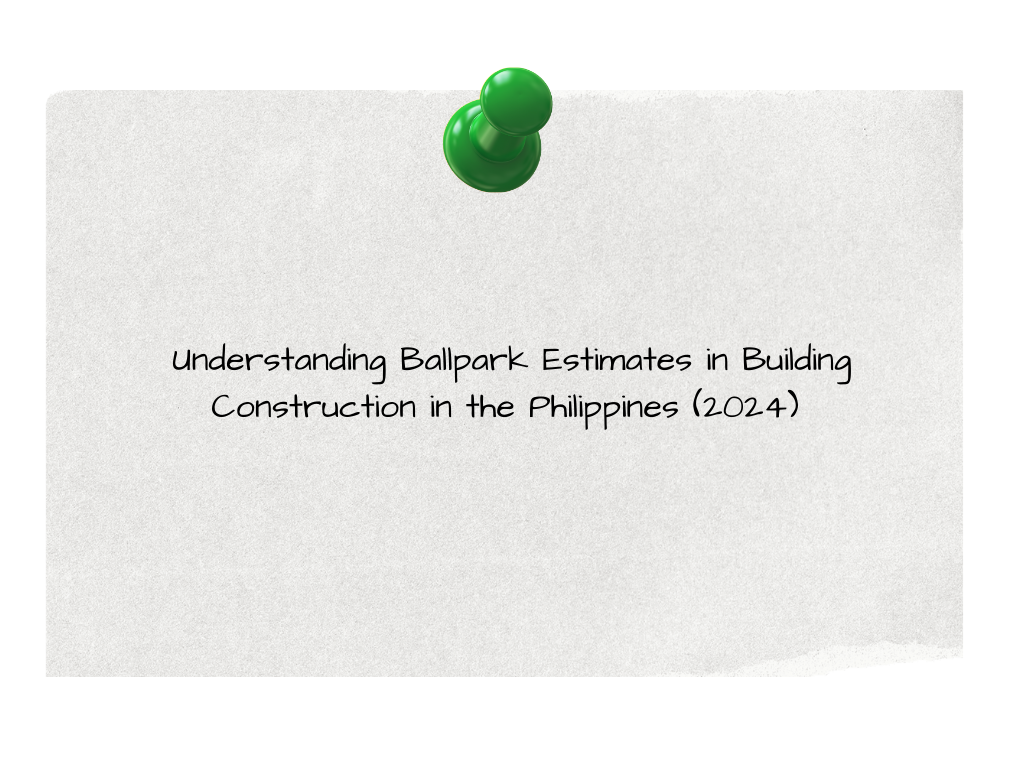Getting a building permit in the Philippines is a very important step in the construction of a building. It is the one that brings a building to the construction field like a birth certificate does in the community, which certifies that the project meets the national building codes, the local ordinances, and safety regulations, of course. For the construction of any building—be it a residential building, commercial building, or a building for a certain institution—local government units (LGUs) need a full set of technical design drawings and documents to be approved. These are the main tools for the picture of the design of the entire building, construction methods used and systems in place, to show that they are all up to the code, and that they are being built safe.
This post explains the necessary technical design drawings and documents that must be presented to an application to get a building permit in the Philippines, as specified by the National Building Code of the Philippines (NBCP) as well as local ordinances.
1. Architectural Drawings
Architectural drawings are the primary architectural blueprint, setting the framework and laying the groundwork for a new structure. These drawings are very crucial to showcase the functionality, aesthetics, and compliance of the building with zoning and regulatory requirements.
Key architectural drawings include:
- Site Development Plan: This is a critical document, telling the whole story of the building site, including siting the structure, access roads, parking spaces, utilities, landscape elements, and setbacks from property boundaries. This plan makes sure that the building meets the local zoning constraints (for example: setbacks, height restrictions).
- Floor plans: They render each floor aspects, like sizes and place of the rooms, the relationship of walls, doors, windows, and other architectural details. Floor plans also identify spaces like kitchens, bathrooms, and stairwells that are functional areas.
- Building Elevations: Elevation drawings illustrate the exterior view of a tower from all sides, making use of fashionable architectural style, windows, doors, finishes, and roofline. The focus of these pictures is on the fact that the possibility that the building could be hidden behind the existing vegetation will be minimized as the design will overlay it with the complementary natural background, and thus the aesthetic requirements will be met.
- Sections and Details: These plans display vertical cross-sections of the building, such as the relation between the floors, the height of each level and the primary components of the structure are some of the necessary points. The ones with full illustrations of doors, windows, and other building components are among them too.
- Roof Plan: The diagram includes the roof layout with the slope, type of roofing materials, and the locations of the skylights, chimneys, and other parts. The roof plan is crucial as it will prevent the stagnant water that can result from precipitation from being present on the roof.
- Interior Layouts: Interior design plans showing how interior spaces such as lobbies, offices, restrooms, and hallways will be treated in terms of wood, glass, mosaic tiles or other materials which best fit the situation.
2. Structural Design Drawings
Structural design drawings ensure the safety and stability of the building. They are prepared by licensed structural engineers and detail how the building will withstand various forces, such as gravity, wind, and seismic activity.
Key structural drawings include:
- Foundation Plans: This plan describes the type of foundation system amidst various options of it such as the slab-on-grade, footing, or pile foundation following the site characteristics, and soil loadings. The foundation plan ensures that the building is stable and secure.
- Structural Framing Plans: These plans depict the disposition of beams, columns, slabs and other load-bearing members that combine to form the building skeleton. They ensure the building will stand up to forces such as wind and earthquakes.
- Structural Details: These detailed drawings provide specifications for connections, reinforcements, and anchoring points for various structural elements. This includes the design of beam-column connections, slab reinforcements, and other critical structural members.
- Structural Calculations: A report or set of calculations showing the load-bearing capacity of structural elements. These calculations ensure that the design is in line with the safety standards set forth in the National Building Code of the Philippines (NBCP) and other related rules.
3. Mechanical, Electrical, and Plumbing (MEP)
Design Drawings MEP systems are necessary for the proper functioning of the building; they include air conditioning to electrical systems to water supply. Moreover, these systems guarantee the safety, comfort, and health of the occupant.
Key MEP design drawings include:
- Mechanical Plans (HVAC): These plans visualize the Heating, Ventilation, and Air-Conditioning (HVAC) systems by showing the design. They show where the ducts, air conditioning systems, fans, and cooling functions are located. The application of the HVAC design is the basis for the improvement of indoor air quality and the regulation of thermal comfort.
- Electrical Plans: Electrical design drawings involving the power distribution system as well as electrical panels, circuits, outlets, switches, lighting, and emergency systems are outlined by the designers. Wiring must comply with safety regulations to prevent electric fires and to guarantee that correct installations are in place to prevent people injuries and equipment loss.
- Plumbing Plans: Drawings show which pipes are for drinking water and the layout of the water supply and drainage systems. They tell us the sizes of the pipes and the locations of the faucets, toilets, showers, water heaters, and septic tanks or the connections to the sewer system. Sanitary modules are the devices used to get rid of fecal waste and provision of safe and adequate drinking water. They can be performed through the septic system or connected to the city wastewater system.
- Fire Protection Plans: The system of fire safety measures, comprising of fire alarms, sprinklers, emergency lighting, and fire exit signs, is supposed to be detailed in the plans. The aim is to evacuate all the building occupants safely in the event of fire or emergency.
4. Sanitary and Sewerage System Plans
Sanitary systems are essential as they help keep the area clean and prevent pollution. The plans describe the way that the wastewater will be collected, purified, and disposed of safely. Wastewater and stormwater management systems of a building have to be in accordance with the local environmental regulations.
Key components include:
- Sanitary Drainage System: The following parts constitute the plans: – the wastewater from the bathrooms, kitchens and the other plumbing fixtures would be collected and the sewage collected in the sewer or septic system.
- Stormwater Management Plans: Documents in this category are the ones that are used to Standard Order, either the processes for the rainwater runoff will be directed parallel with the building avoiding flooding and the rip-off by the rainwater of the building. It may also be provided for storm drains, retention ponds, and drainage systems.
5. Bill of Materials and Specifications
The Bill of Materials (BOM) and specifications display the list of materials to be used, as well as the type of finishes and the construction methods to be used in the course of the project. A system of inspection is created which ensures the proper materials and methods of construction are approved and thus the minuses of mistake during construction are mitigated.
Key documents include:
- Bill of Materials (BOM): A comprehensive list of materials, their quantities, and their quality. This helps the contractor estimate costs and purchase materials for construction.
- Technical Specifications: A document that outlines the quality and type of materials to be used for different parts of the building (e.g., flooring, roofing, finishes). It also provides guidelines on the construction techniques and quality standards to be followed.
6. Energy Compliance and Sustainability Design
The role of energy efficiency in gaining building permits has started to play a bigger part in the construction industry as sustainability becomes a focal point itself. Some LGUs require evidence of the application of energy-saving measures.
Key documents include:
- Energy Efficiency Compliance Report: This document shows that the building design adheres to energy efficiency standards. It may include the design of passive cooling systems, energy-efficient lighting, and renewable energy sources such as solar panels.
- The need to focus on sustainability: rainwater harvesting systems, green roofs, and solar power systems are prevalent nowadays in building projects.
7. Permit Application Forms and Supporting Documents
Finally, technical drawings, as well as the other documents, have to be joined by the various forms and certifications for the building permit application.
Main documents are:
- Building Permit Application Form: The form provides the groundwork of the project such as the location of the project, the type of building being constructed, and the names of the owner, architect, and contractor.
- Owner’s Affidavit: A document signed by the building owner verifying the accuracy of all submitted documents, and agreeing to comply with the building code, and other local ordinances.
- Zoning Clearance: This document issued by the local land use office states that the proposed project complies with local zoning laws, such as land use, building height, setbacks, and other requirements.
Conclusion
The process of obtaining a construction permit in the Philippines is extensive. The initial requirements of documents such as technical design drawings and plans are necessary for the permit issuance. These documents guarantee that the design of the building is within the safety limits, local ordinances, and environmental factors.
By involving professionals like architects, engineers, and other professionals with the necessary qualifications, you can be sure that your construction project will be approved by the local building authorities and the permitting process will go off without a hitch. Always verify that your technical design package is all complete, real, and binding by the National Building Code of the Philippines and any other concerned regulations.




3 thoughts on “Required Technical Design Drawings and Documents for Building Permit Purposes in the Philippines”